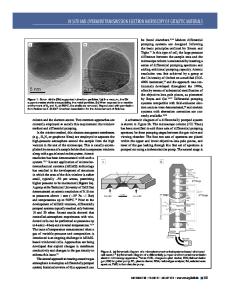In situ high-resolution transmission electron microscopy of material reactions
- PDF / 1,395,420 Bytes
- 8 Pages / 585 x 783 pts Page_size
- 59 Downloads / 426 Views
troduction I feel very honored to be given the opportunity to present an overview of our work on the development and application of in situ observations, at the atomic level, of reactions in materials. The primary investigative technique is high-resolution transmission electron microscopy (HRTEM), complemented in many cases by parallel bulk measurement studies. The current status of this approach is addressed, especially in light of the new generation of aberration-corrected transmission electron microscopes (TEMs) with image and probe-forming resolutions well below 0.1 nm. The scope of in situ experiments is increasing with time, which can lead to an ever more fundamental understanding of materials behavior.
Background HRTEM was largely developed for atomic resolution imaging during the 1970s (e.g., References 1 and 2) by a combination of instrumental improvements to the TEM combined with theoretical understanding. The first likely dynamic HRTEM observations, of dislocation movement in gold stimulated by the imaging electron beam, were reported by Hashimoto et al. in 1980.3 Our own recordings on the semiconductor CdTe followed shortly thereafter.4,5 However, we realized that temperature control by utilizing the electron beam is not
adequate, and, moreover, other electron-specimen interactions cannot be precluded by this approach. Accordingly, Parker demonstrated in 1986 that commercially available heating holders had both the necessary mechanical and temperature stability to allow high-resolution imaging, with minimal specimen drift at controlled elevated temperatures,6 and that video-rate recording to follow the behavior over extended periods of time was possible. There were several major concerns at that time, principally whether the observations by in situ HRTEM on thin samples were representative of the bulk material. Accordingly, we concentrated our efforts on studying reactions at material interfaces in cross-section, whereby alternative bulk measurements (e.g., differential scanning calorimetry, x-ray diffraction) could be made in parallel. This approach benefitted immensely from our sample preparation of cross-section specimens, as clearly described by Bravman.7 It was even not clear then that the epoxy involved in the preparation could withstand the higher temperatures, but this turned out not to be an issue. Parker showed that the rate of solid phase epitaxial regrowth of amorphized silicon showed the same kinetic behavior as that determined by high voltage electron microscopy and by Rutherford backscattering spectroscopy on the exact same samples.8,9 This and other examples of this type of work are
Robert Sinclair, Stanford University; [email protected] DOI: 10.1557/mrs.2013.285
© 2013 Materials Research Society
MRS BULLETIN • VOLUME 38 • DECEMBER 2013 • www.mrs.org/bulletin
1065
IN SITU HIGH-RESOLUTION TRANSMISSION ELECTRON MICROSCOPY OF MATERIAL REACTIONS
Figure 1. (a) Individual consecutive video frames (unprocessed) showing the disappearance (b) and reappearance (c) of individual atomic colu
Data Loading...











